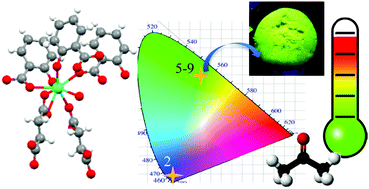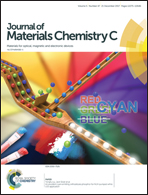Sensing properties, energy transfer mechanism and tuneable particle size processing of luminescent two-dimensional rare earth coordination networks†
Abstract
A new isostructural family of layered coordination networks (CNs) based on rare earth elements and mixed ligands was hydrothermally synthesized and fully characterized. The set of compounds with the general formula [REE(Salicylate)(Succinate)0.5(H2O)] (with REE = Ho or Y) belong to the monoclinic P21/c space group. Top-down methods were implemented in order to obtain nano-sized CN particles for potential application in thin film fabrication. The solid state photoluminescence (SSPL) of the Eu, Tb and Eu/Tb doped samples was explored in terms of excitation/emission spectra, lifetime values and quantification of light emission by the CIE chromaticity calculation. Measurement of the triplet state energy of the ligand at low temperature was carried out by analysing the SSPL of the Y-based compound; energy transfer pathways were studied. According to the high performance of the Tb-doped compound as a green emitter, thermal and chemical sensing assays were carried out.



 Please wait while we load your content...
Please wait while we load your content...